 
KUKA Refuse Bodies in North America
By Eric Voytko
The KUKA Shark was perhaps the only European-designed refuse body to ever tap into the American market, although only marginally. In 1969, the city of Rolling Meadows, Illinois was among the first in the U.S. to incorporate the Shark into their refuse collection fleet. The story begins in 1966, when forward-thinking Public Works Superintendent James McFeggan had observed the custodian at City Hall emptying trash cans, and how the wind often scattered litter about. As an experiment, he installed disposable paper sacks with special hangers in place of the cans, and the litter problems at City Hall disappeared. He tried the paper sacks art his own residence as well, and in late 1967, McFeggan began to investigate the potential for using paper sacks for city-wide refuse collection.
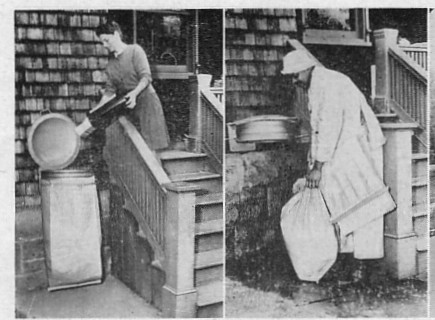
Homeowner empties refuse into sack suspended from special holder, and collector removes sack for disposal
(Montclair, New Jersey 1961)
The unsightly appearance of cans, as well as improper container use resulting in litter could be alleviated with such a system. There was precedent dating back over a decade in several cities including Hartford, Connecticut (1955), Fredericksburg, Virginia (1960), Montclair, New Jersey (1961), Buffalo, New York (1963), and in Riverdale and College Park, Maryland (1963). The sack suppliers were primarily Union Paper, Westvaco and St. Regis Paper. In the earliest systems, the heavy paper sacks were used as "liners" in the homeowners existing steel cans, which were removed by the collection crews. Later, special sack hangers with sealing lids (which remained property of the city) were developed. Homeowners were given an unlimited supply of sacks, which were then set out for pickup instead of cans. The sacks were not only durable, but also sanitary, eliminating blown refuse the build-up of grime in trash cans. Collections went faster, often too fast for conventional packer truck cycling to keep pace with.
After a pilot program in select neighborhoods, Rolling Meadows initiated sack collection on a citywide basis in May of 1969, using the St. Regis system. Partly as the result of a 1968 strike, they also ended their collection contract with Barrington Disposal and purchased three KUKA Shark refuse bodies on Mercedes-Benz trucks. The Shark was chosen because of its continuous-loading rotary drum, which was better able to keep up with the speed at which the collection crews were operating with the sack system. Additionally, the Shark was well suited to the task since it tended to tear-open and shred the sacks as they entered the body, helping to eliminate air pockets and voids. And of course, the Shark was capable of swallowing and crushing large objects also left out for collection.
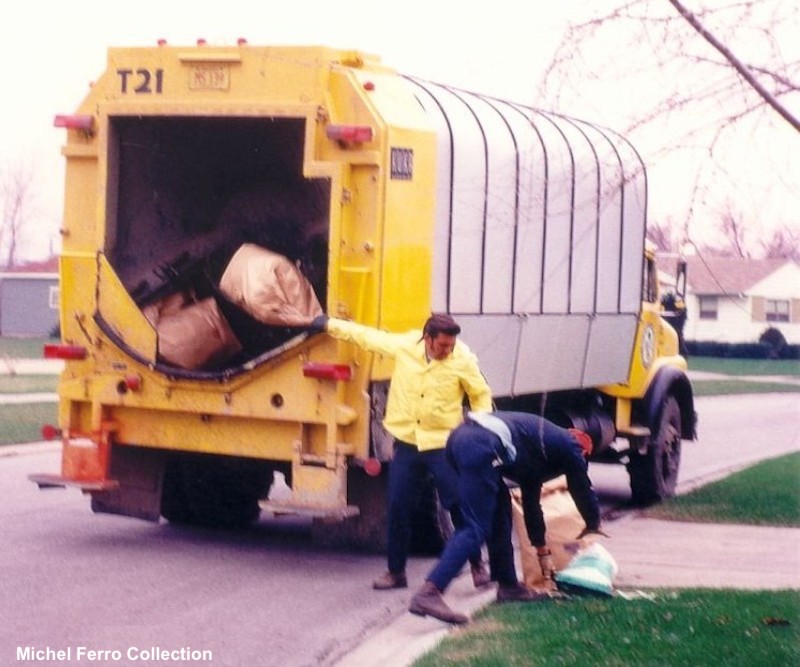
With its continuously churning drum, the Shark was well-suited for fast collection and shredding the paper sacks
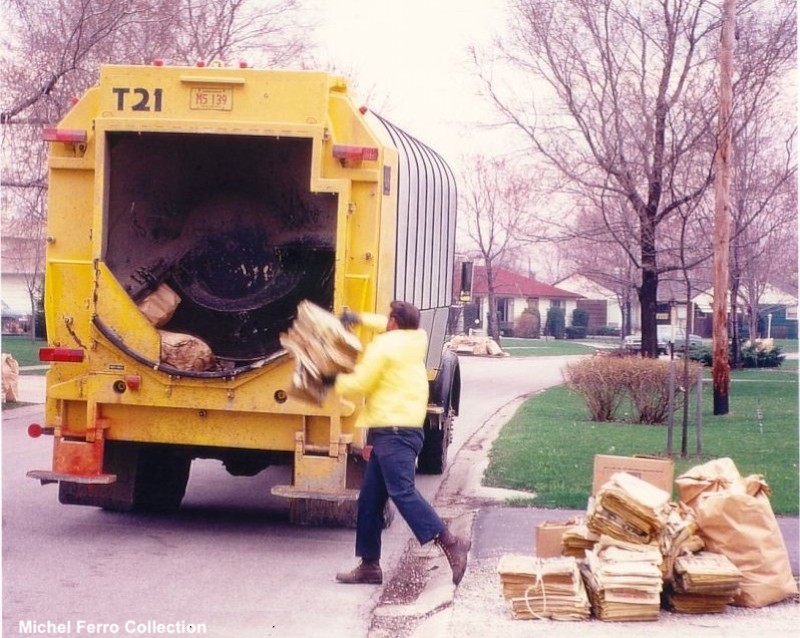
In addition to sacks, the KUKA body could devour anything else left at the curb, right up to furniture and white goods
St.Regis Paper began to market their sack system in conjunction with the KUKA Shark on a nationwide basis in the early 1970s. It is unknown if this marriage came after the Rolling Meadows experience, or whether the Shark had been recommended to the city by St. Regis. Regardless, it did offer KUKA an entry into the lucrative U.S. Market, in which there were no continuous loaders that would work as well with the sack system. Rolling Meadows received a fair amount of publicity in the 1970s, a great deal of which seemed to center on their use of Mercedes-Benz trucks. While Europeans were well acquainted with Mercedes-Benz commercial vehicles, being one of the world's largest producers of motor trucks and diesel engines, the American public mostly knew Mercedes for their high-end luxury cars. Thus, the press mostly ignored the novel aspect of the KUKA bodies and happily played up the "luxury truck" angle in their headlines. However, as the City took over collection from Barrington, they lowered (and ultimately eliminated) refuse collection assessments. Any ribbing of the department in the press made little difference to those who mattered, namely the taxpayers of Rolling Meadows.
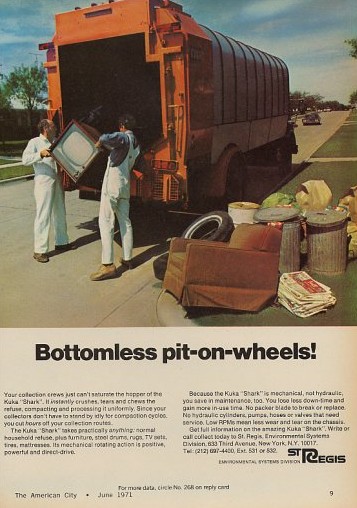
St. Regis marketed their paper sack system with a truck; the Kuka 215 "Shark"
Rolling Meadows Merecedes-KUKA packers, which eventually numbered five in all, provided good service and long life. When the last one was retired in 1981, the City could point with pride to an investment that had far outlived the initial jokes, proving their worth in years of service. Indeed, the local papers reported the retirement with some fanfare, and the Public Works Department ultimately decided to keep one of the original trucks, which was cobbled together from the parts of two, for use in parades and special events. The city still provides collection services for its citizens, but the paper sack collection system was terminated in 2010, after an amazing 40-year run. Brad McFeggan, grandson of the James McFeggan recalls that his grandfather's advocacy for the system did not end at Rolling Meadows:
"By 1974 both my grandfather and the Mayor of Rolling Meadows were huge advocates for these systems. The Mayor, Roland Meyer, started a consulting firm called Midwest Environmental Systems Inc. My grandfather became an employee salesman for the firm. Roland went around trying to sell these types of systems (including the Orbital system) to other towns, using Rolling Meadows as the proof of how well the systems work. My grandfather would frequently bring potential clients to Rolling Meadows to see the demonstrations of the Kuka Trucks."
As planned, the refurbished truck was indeed brought out for parades and special events for a few years. According to press accounts, it is likely that the rotary packer was no longer functional on the truck. Sometime between 1989 and 1993, this parade truck was also auctioned off by the city, and its current whereabouts are unknown. However, due to the large amount of publicity surrounding this unique vehicle during its service, there remains a good possibility that it is still in existence and intact, perhaps sitting in an Illinois barn somewhere, waiting to be rediscovered some day.
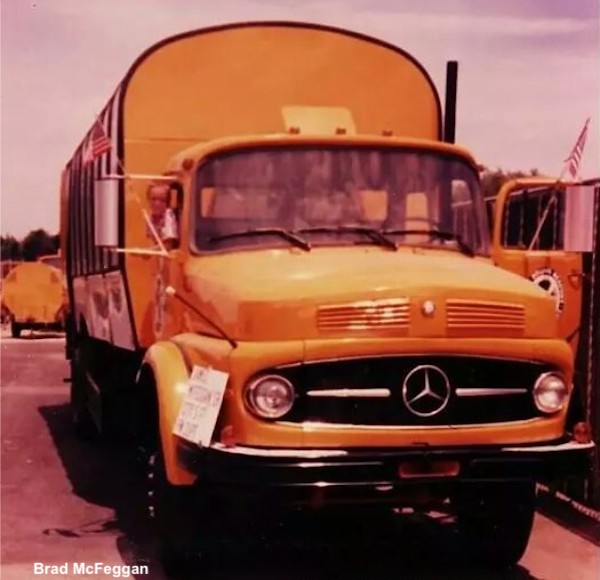
The last Rolling Meadows Shark, shown here refurbished as a parade truck
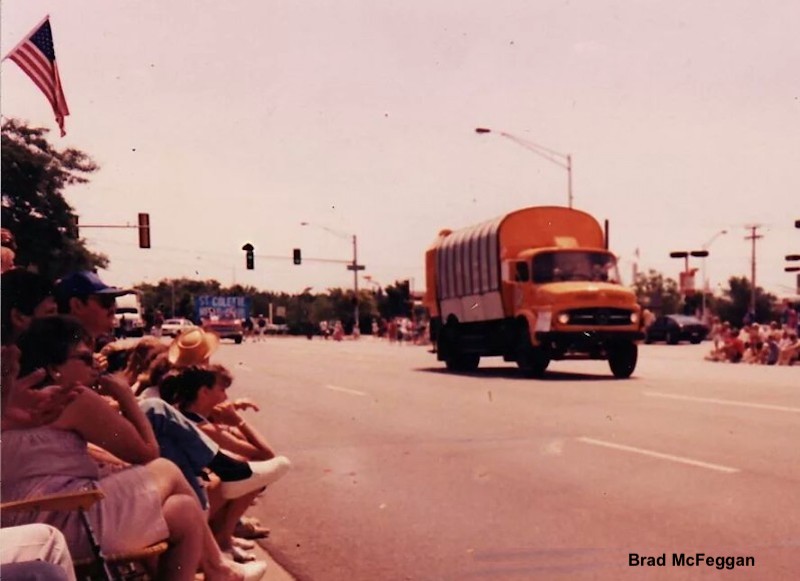
The last Shark shown here on parade duty; it was eventually auctioned off in the early 1990s. Could this truck still survive today?
OTHER SHARKS IN NORTH AMERICA
The earliest known KUKA Shark in service on the North American continent belonged to Metropole Refuse Disposal of Montreal, Quebec. Shown here is truck 48, a 1968 Chevrolet with what looks like a 27-cubic yard body. It bears 1968 Quebec license plates, which confirms its age. It is one of a small fleet of Sharks owned by Metropole.
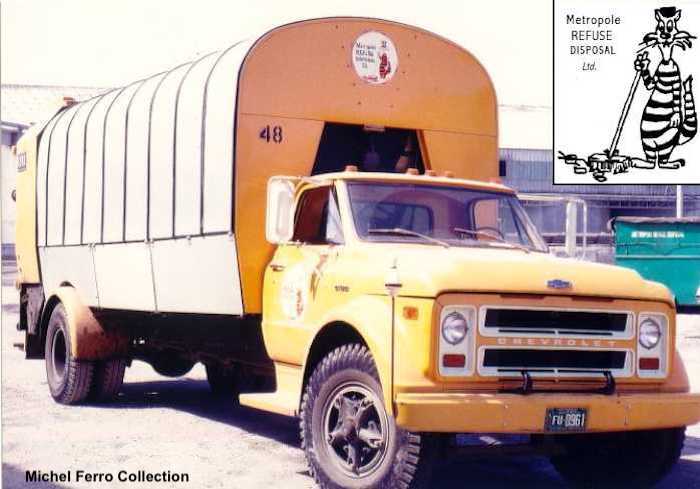
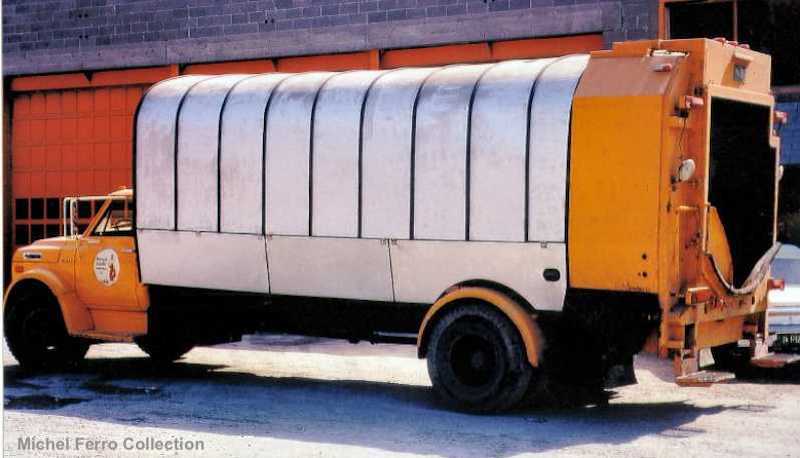
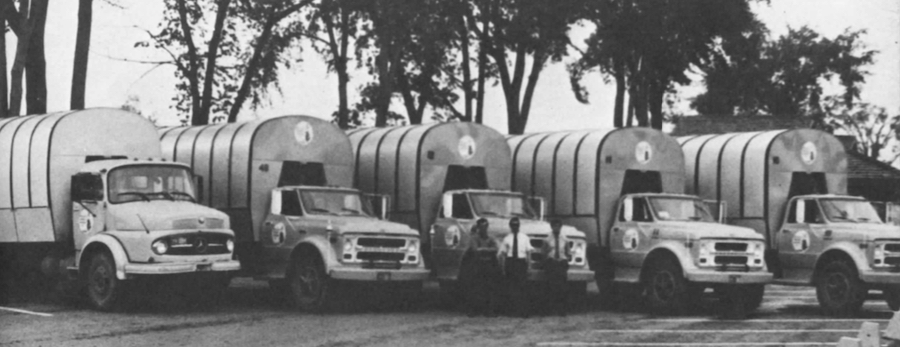
The owner of this 27-yard KUKA Shark on a GMC tilt-cab tandem is not identified. Clues include the palm tree visible in the background, and the rear license plate which appears to be a 1970-71 Florida tag.
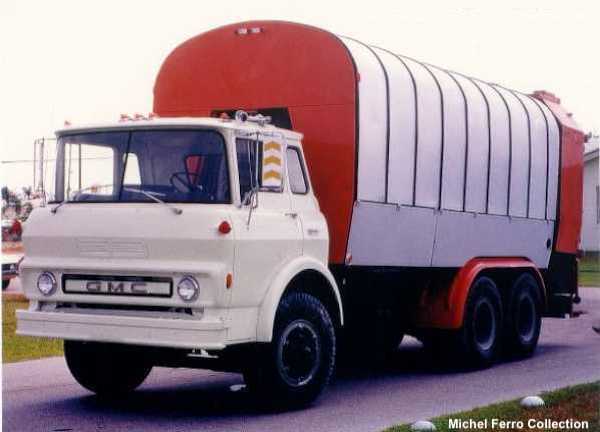
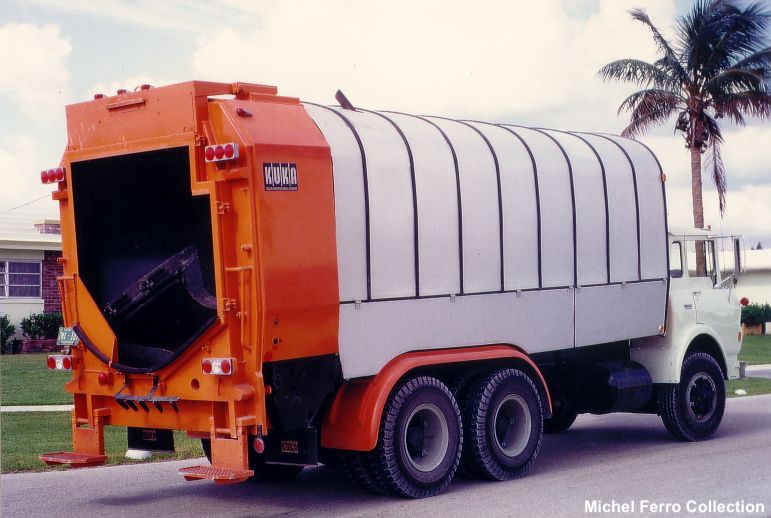
Yet another 27-yard Shark, this time mounted on a White Compact. The front view shows a white-colored license plate marked "D7B" (which may be Dealer plates from New Jersey) suspended temporarily above the grill. To the right of the truck are several "Penn Franklin" oil drums. This is likely a demonstration unit, possibly being tested in Philadelphia or Camden, New Jersey in the early 1970s.
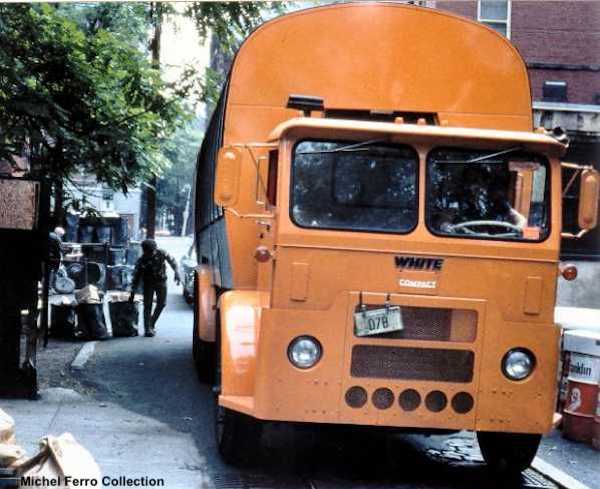
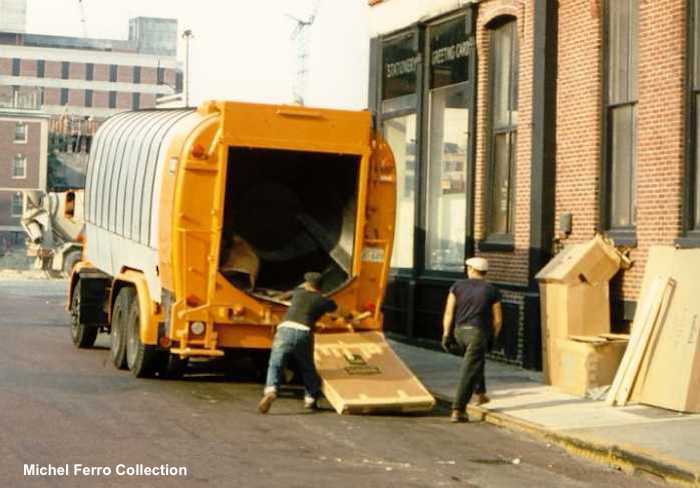
This Shark on a Ford Super-Duty was owned by a A.S. Gilbert of Kingston, New Jersey.
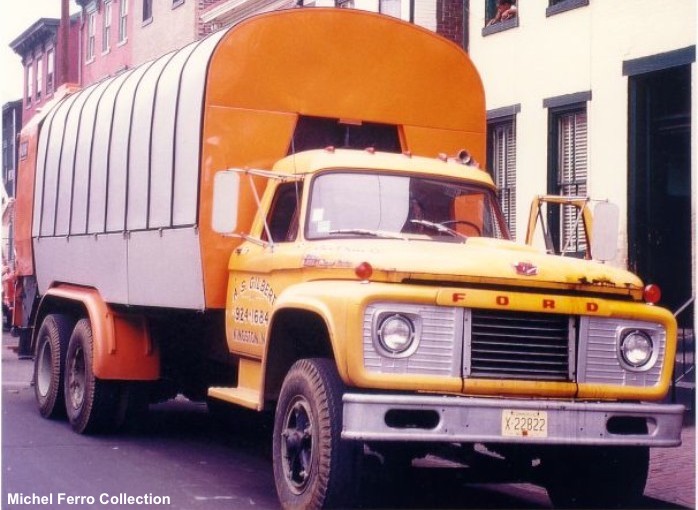
Orbital Collection Systems (Washington DC) briefly sold the KUKA 215G as the "Orbie" in 1973-74
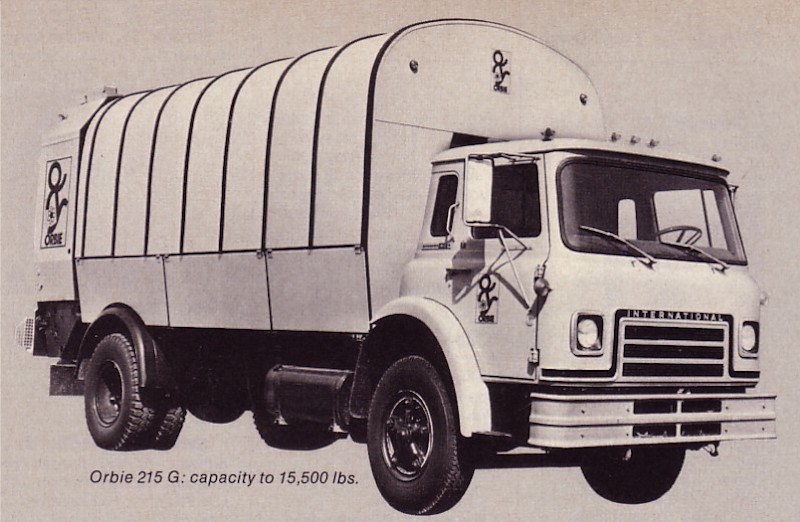
Next: Other Rotary Refuse Bodies



1/3/15 (revised 4/8/23)
© 2015
All Rights Reserved
Photos from factory brochures/advertisements except as noted
Logos shown are the trademarks of respective manufacturers
|
| 













